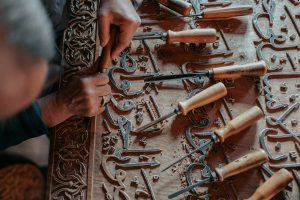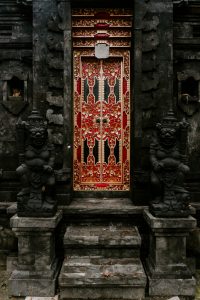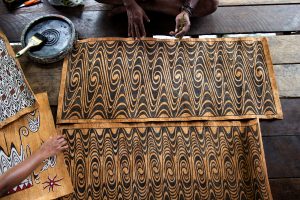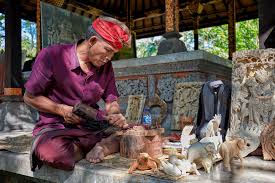The Art of Indonesian Wood Carving


Wood Carving in Indonesia
Woodcarving is the most enduring and widespread medium for artistic expression in Indonesia. Each Culture has its own style, and the diversity and sophistication of Indonesia’s woodcarvers is remarkable. In Indonesia a house not only protects its inhabitants from the elements but repels unwanted spirits. Examples include the horned Singa (lion) heads that protect Batak Houses, the water buffalo representations on toraja houses sigifying prosperity, or the serpents and magical dog carving on Dayak houses in Kalimantan.
Objects made of wood can have spiritual, artistic and functional purposes or elements of all three. Some of the more lovely functional objects are ironwood stools from Kalimantan, carved bamboo containers from Sulawesi and doors from Timor. Perhaps the most famous artistic and spiritual carvings are masks. They are associated most with the masked dance-dramas of Java and Bali but are also used in dances and funeral rites and ceremonies on other islands.
Used in prehistoric times in burials, the use of ancient spirit masks has given way to masks used in many traditional dances. These highly stylized masks, topeng, depict the various characters in the story told by the dance. Masks enable the performers to assume new identities and depict a variety of characters from demons to animals, princes or gods. Amongst the most famous masks used in dance are the Rangda and Barong masks from Bali. In this traditional dance, performed often for tourists, the interaction of Rangda, representing evil, and the Barong, representing good, restores the harmony between the good and evil in life. While masks for sale in stores are primarily from Central Java and Bali, masks from other ethnic groups were used widely in the past to communicate with ancestors, for blessings for harvests, protection from evil spirits, to acquire new personalities or great powers.
Bali Wood Carving History
The rise of Balinese wood carving can be traced back hundreds of years ago to the time when Hindu-Javanese preachment was set in motion. In the beginning wood carvings in Bali functioned as a mode of expression for carrying out religious ceremonies, and primarily the use of carvings was limited only inside the temples and palaces. This set of circumstances passed along until the twentieth century. Back in those days, ornamental frames, ornate doorways, statues of gods and deities, and masks were made for the sole purpose of paying homage. Very often they were symbolized as objects of guardianship. Besides, it was not an uncommon phenomenon to find wooden panels and sculptures of the time as interior decoration pieces. 
The art of Balinese woodcarving had its beginnings around the twelfth century. Formerly, local carvers used the stone as the sole material to form carvings. It was not within the bounds of possibility for them to carve wood beforehand as this form of art required a higher level of skill and precision. This can be seen from the finish on the wood carving which looks more polished than the other types of carving. The aesthetics that was of interest to the people at that time were a blend of Buddhist and Hindu influences. However, the impact of Buddhist preaching slowly waned when Majapahit conquered Bali in the thirteenth century. The traditional Hindu teachings that were brought about certainly shifted the influence of Buddhism, which automatically affected traditions that had previously taken root in various aspects of Balinese life, including the emergence of new rules that restricted sculptors from creating only god and human figures in their artwork. Until then, the general public purely considered the sculptures and paintings they created as a means of worshipping alone. However, a shift in mindset on a large scale in the Balinese art world emerged in the early twentieth century.

Dutch traders felt the potential to put up carvings made by local Balinese artisans for sale in the international market. There was a great demand for Balinese wood carvings generally in Europe which even convinced some Western artists to settle in Bali and start over their careers there. Some of the leading artists who have been noted living in Bali due to the wide-ranging frenzy of Balinese wood carving include Jaap Kunst, Rudolf Bonnet, and Walter Spies. Ubud and the surrounding villages became the most prominent art center in Bali at that time, thanks to the growing popularity of Balinese wood carving in the international market. Several Western artists who have been previously mentioned were known to providing assistance and initiating the reconstruction movement of Balinese carvings and paintings which had previously been corrupted by the Dutch invasion of the island. The Dutch occupied Bali for two years since 1906, and because of this, the ingrained tradition of long-established artmaking was eroded. Balinese craftsmen are required to labor their full ability entirely to produce commercial goods rather than objects for religious purposes. This ultimately influenced the choice of subjects that appeared in the sculptures marketed after World War II ended when Bali was liberated from Dutch colonialism. Rudolf Bonnet and Walter Spies strived to guide Balinese craftsmen on how they could promote their lines of work to the European market. This movement later inspired other local craftsmen to develop fresh carving techniques and styles. To this day, local craftsmen can continue to produce stunning Balinese wood carvings for a variety of purposes without being constrained by restrictive rules or limitations. You can observe this from the use of statues for religious ceremonies, wall hangings as interior decoration, to other marketing purposes on a daily basis.
What wood is used for Balinese carvings?
In Bali, many different types of wood are used for carving. Some examples include teak, crocodile wood, acasia, sonokeling (rose wood), macassar ebony, palissander, suar, jackfruit, shorea (meranti), mirabouw, panggal buaya, mahogany or sandalwood.
Balinese Wood Carving Characteristics
Balinese carving products have their distinctive motifs. These motifs are relics of ancient kingdoms that have experienced advances in the world of arts. The motifs are recognized by several distinctive features that are divided between general and specific characteristics. The general characteristic is that Balinese wood carvings have convex and concave motifs of leaves, flowers, and fruits.
